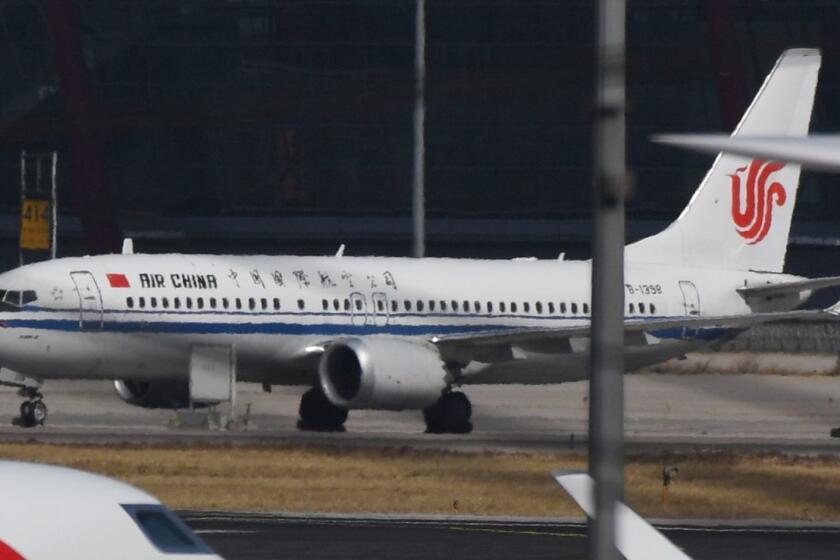Boeing pauses 737 Max production, trying to slow cash burn

- Share via
Boeing Co. will halt production of the grounded 737 Max plane in January, a move that will deepen the crisis engulfing the company, complicate its eventual recovery and ripple through the U.S. economy.
Employees at the Seattle-area factory where the Max is built will continue 737-related work or be temporarily reassigned to other programs, the company said in a statement Monday. No layoffs are planned for now, it said.
The production pause deepens one of the worst crises in Boeing’s 103-year history, as the company waits for regulators to clear its bestselling plane to resume commercial flights. The factory shutdown will also jolt a supplier base that stretches from the Seattle area to Kansas, adding a headwind for U.S. industry as the 2020 elections near.
Financial pressure on Boeing is rising as almost 400 newly built aircraft languish in storage due to a global flying ban that began nine months ago. The timing of regulatory approval for the jet’s return is uncertain, with Boeing’s relationship with the U.S. Federal Aviation Administration in tatters.
“We believe this decision [to pause manufacturing] is least disruptive to maintaining long-term production system and supply chain health,” the company said. The decision is based on such considerations as “the extension of certification into 2020, the uncertainty about the timing and conditions of return to service and global training approvals, and the importance of ensuring that we can prioritize the delivery of stored aircraft.”
The announcement came after the close of regular trading, and in after-hours trading Boeing stock fell less than 1%. Shares of Spirit AeroSystems Holdings Inc., a Boeing supplier that makes about 70% of the Max’s frames, tumbled 5.4%.
Although Boeing isn’t planning layoffs, its decision heightens the risk of job cuts at suppliers.
“If it shuts production down, it risks losing employees and having greater difficulty ramping back up in the future; and the same goes for the supply base,” Cai von Rumohr, an analyst with Cowen, said in a note to clients before Boeing’s announcement. “If it only trims its rate, it risks further extension in the already lengthy time required to liquidate its sizable inventory” of stored Max planes.
Chinese air carriers have largely stopped hiring foreign pilots for Boeing’s 737 Max.
The production decision became more urgent after the FAA signaled it wouldn’t certify the revamped Max this year. Boeing executives had repeatedly warned that they would have to address plans for output if the grounding extended into 2020.
The Max was grounded after an Ethiopian Airlines flight plunged into a field on March 10, five months after a similar crash of a Lion Air flight off Indonesia. The tragedies killed everyone aboard the two Max planes, a total of 346 people, and prompted the longest flying ban for a U.S. airliner in the jet age.
Boeing slashed 737 production 19% in the weeks after the Ethiopia crash. But inventory costs have ballooned to record levels as the company plotted a quick rebound once the narrow-body jet was cleared to resume flights. Boeing left its supply chain mostly running at the original pace, while the plant in Renton, Wash., lowered monthly output to 42 jets.
Since the company isn’t allowed to deliver the aircraft while the grounding remains in place, Boeing has already placed more than 380 new planes in storage, according to a tally by 737 production blogger Chris Edwards.
Boeing is burning through $4.4 billion in cash for each quarter that the Max remains grounded, according to Jefferies analyst Sheila Kahyaoglu. Halting production would save about half that amount, she said in a report.
However, a delay to the aircraft’s certification past the end of 2019 could force Boeing to take an additional accounting charge. Kahyaoglu said a $3.6-billion write-down was likely if program accounting costs double. That would clip profits longer term for Boeing’s biggest source of revenue.
Boeing’s board gathered after a bruising week for the aerospace giant. In a sign of growing rancor between the company and its regulator, FAA Administrator Steve Dickson chastised Boeing Chief Executive Dennis Muilenburg in a meeting Thursday for pursuing an unrealistic schedule for the Max’s return to service.
The FAA said it was worried that Boeing was publicly pressuring regulators to take action even as the company failed to provide data as requested. In a message to Congress before the session, the regulator exhorted Boeing to focus on the “quality and timeliness of data submittals for FAA review.”
The rare public admonishment came the day after Dickson was grilled for hours by the House Transportation & Infrastructure Committee over the FAA’s decision to let the 737 Max keep flying after the initial fatal Max crash off the coast of Indonesia on Oct. 29, 2018.
The FAA’s insistence that the Max wouldn’t be cleared to fly until next year, and Dickson’s refusal to estimate a timeline, signal that the U.S. agency is increasingly unlikely to clear the Max before regulators in other regions.
The uncertainty raises the possibility that U.S. carriers will be hamstrung for a second summer while awaiting Boeing deliveries and training pilots. American Airlines Group Inc. has delayed a return of the planes to its schedule until early April. Southwest Airlines Co., the largest operator of the single-aisle plane, said it was considering a similar move.
With the halt to production, the largest U.S. industrial company by market value risks a potential unraveling of manufacturing expertise across a broad swath of North America.
Boeing so far has shielded the 600 mostly U.S. companies building components for the jet from rate cuts, mindful that its own recovery would be greatly complicated if layoffs prompted engineers and mechanics at suppliers to move on to other jobs.
The company had considered pausing Max manufacturing for a short period, Bloomberg reported in August. Executives figured that the approach would conserve cash and be less likely to trigger widespread layoffs than imposing another factory slowdown.
Boeing officials haven’t discussed the finer points of how they would manage through a shutdown, including details like worker pay. But the idea is that coveted employees would prefer the certainty of a surgical shutdown to an open-ended period of slower production that could lead to layoffs.
The 400,000 parts that go into each Max arrive in a tightly choreographed sequence timed, in some cases, down to the hour. But suppliers regularly navigate stoppages telegraphed in advance, such as for strikes and Boeing’s traditional year-end factory closing — which could be extended this year into the longer pause.
With production suspended, Boeing will have to carefully nurse suppliers back to the current pace before contemplating an even faster production tempo it had once planned for 2020.
Further complicating matters, the FAA is insisting on inspecting planes coming out of storage before they are delivered. That raises the prospect of bottlenecks as the agency takes over certification tasks that it handed over to Boeing more than a decade ago.
Johnsson writes for Bloomberg.
More to Read
Inside the business of entertainment
The Wide Shot brings you news, analysis and insights on everything from streaming wars to production — and what it all means for the future.
You may occasionally receive promotional content from the Los Angeles Times.











